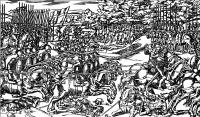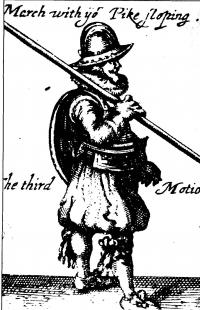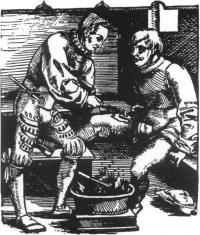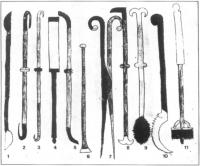The Dead, Sick and Wounded of the Nine Years War (1594-1603)
Published in Early Modern History (1500–1700), Early Modern History Social Perspectives, Features, Issue 4 (Winter 1995), Volume 3![The battle of Beleek 1593,drawn by Ensign John Thomas[Courtesy of The British Library]](/wp-content/uploads/2013/01/The-Dead-Sick-and-Wounded-of-the-Nine-Years-War-1594-1603-1.jpg)
The battle of Beleek 1593,drawn by Ensign John Thomas
[Courtesy of The British Library]
Burden on poor law
Demobilisation was anticipated with dread in many ports and shires of England and Wales; some of the soldiers had been vagrants and criminals whose return from Ireland was not expected and certainly not wanted. Those who had performed honourably often came back wounded to their native parishes sorry victims of the horrors of war; unable to take up their former employment, many became a burden on the poor law. As a direct result of the Irish wars the shires in England and Wales began to pay pensions for maimed soldiers but the steady increase of masterless men added to the problems of poverty and vagrancy and therefore strained the meagre resources of the poor law administration. The privy council admitted that it was the war in Ireland rather than those in France and Spain which had impoverished England. Sir Robert Cecil echoed their sentiments when he punned: ‘How that land of Ire hath exhausted this land of Promise’.
![The battle of Beleek 1593,drawn by Ensign John Thomas [Courtesy of The British Library]](/wp-content/uploads/2013/01/The-Dead-Sick-and-Wounded-of-the-Nine-Years-War-1594-1603-2.jpg)
Captains Hunger, Toil, Cold and Sickness
English soldiers in Ireland were wont to say that their four best officers were ‘Captains Hunger, Toil, Cold and Sickness’. Many dispatches from Ireland mention that sickness killed more men than the sword and that it particularly affected new recruits. Others speak of the ‘disease of Ireland’, a general term for ague and dysentery brought on by a combination of poor diet, inadequate lodgings in garrison, and the ‘raw and waterish’ Irish climate. Captain Nicholas Dawtry, of long service in Ireland, wrote to Cecil in February 1601 that his horsemen had not been able to endure even one month’s bad weather as some of them were ‘dying of agues and fluxes, others Iying sick, hurt and impotent…good for nothing but to hang upon their master’s beef-pot and buttery’. All kinds of maladies were attributed to the ‘foulness’ of Irish weather but more than likely ignorance of the first principles of hygiene and the excesses of the soldiery were the real culprits. Even well fed garrisons often suffered from what the Elizabethans called ‘the flux or the looseness of the country disease’. Dysentery and typhus were liable to break out in any camp that stayed in one place longer than a fortnight. Fynes Moryson suggested that the flux did not affect Irish soldiers because their favourite drink was usequebah or whiskey. And, in the later stages of the war under Mountjoy, it was a disease that did not greatly affect his troops; his secretary Fynes Moryson hints he kept his field army on the move thereby reducing the incidence of camp diseases which became the affliction of so many of Sir Henry Docwra’s men in the Lough Foyle garrisons.
Dysentery and typhus struck the Derry garrisons within six months of their landing in April 1600; of a force of nearly 4,000 there were barely 1,500 fit men a year later and losses continued among the reinforcements sent in December 1600. As an antidote to dysentery Docwra laid in stores of 4,000 Ibs. of liquorice and 1,000 Ibs. of aniseed to make medicinal drinks but they were not effective. It is to his credit as a commander that Docwra was among the first to see the necessity of establishing a military hospital as an investment for the army in Ireland: it would reduce the number of sick and wounded returning to roam the English countryside who discouraged potential recruits for the war in Ireland.
The casualties
Medical attention to the battle wounded had improved by the last decade of the sixteenth century, but much depended on the speed with which the wounded were removed from the field to the army surgeon. Captain Hugh Mostyn, a Welsh soldier who claimed a lifetime’s experience of the wars in Ireland, vividly described the fate of the wounded in battle in November 1598:
the longer they be carried as an act of mercy the more danger and trouble shall be with them…unless the wounded be able to shift for himself or have great friends in the camp (which every common soldier hath not) he is but lost, and so the longer they are forth, the more will increase the number of the wounded and hinder the service…
Contemporary reports of killed and wounded on both sides exaggerate the losses to the enemy. When numbers are given they tend to be in round figures which we can justly suspect as inaccurate. Vague phrases were employed such as ‘hundreds lay slain on the field’, ‘great numbers were killed’. Sometimes the number of English casualties was deliberately concealed. Sir Ralph Lane, the muster master general, wrote to Burghley after the disastrous defeat by O’Neill at Clontibret in 1595 that ‘more men were hurt and killed in the late service than was convenient to declare’. Philip O’Sullivan Beare, the Gaelic recorder of the war, wrote that it was an English custom to conceal their own dead and to expose their slain enemies in public places. Dispatches on battles, sieges and skirmishes are somewhat sounder on numbers of casualties.
At the onset of the war the struggle to gain fording points on the Erne such as Enniskillen, Beleek and Ballyshannon occasioned much loss of life. In three major engagements seventy-four English were killed and eighty-nine wounded; the casualities on the Irish side was probably about 350. In May 1595 when Hugh Maguire re-took Enniskillen the attenuated English garrison of only fifteen men was slaughtered. Casualties at Clontibret are difficult to assess; English dispatches mention thirty-one English killed and 109 wounded, Irish say 700 English dead, while the Irish reports of their own dead vary between zero and 400. Lieutenant Tucher’s report from the actual battlefield says ‘100 Irish enemy slain and many hurt’.

‘Sir Henry Sidney’s army in battle with an Irish force’
-in the background mail-armoured gallowglasses flee into the woods to escape the withering fire of arquebusiers – from John Derricke, The image of Irelande(1581)
Siege of Carrickfergus
The worst disaster to befall any single garrison in the war was at Carrickfergus, where O’Neill’s Scottish allies wiped out 180 of Sir John Chichester’s men from a garrison of not more than 250. About thirty saved their lives by swimming Lough Larne. Lieutenant Hart, one of the survivors, listed the names of the officers killed and wounded and claimed that most of the casualties occurred because they lacked gunpowder. Heroically, Sir John Chichester, the governor, tried to rally his men and though he had already suffered a leg wound he mounted his horse, charged down the slope and then suffered a fatal wound in the head. With the commander’s death the rest became demoralised; dismayed they dissolved battle; horses and men took to the river and some made it to Island Magee. Captain North’s horse was shot from under him; Captain Constable was taken prisoner with a head wound;

‘March with yo(u)r pike sloping.
Merriman was shot through the shoulder. Hart’s dispatch summed up the losses:
The number of men that were lost in my judgment were about nine score, and there were hurt between thirty and forty, most of which recovered.
Battle of the Yellow Ford
At the Yellow Ford in August 1598 English forces suffered their highest losses in a single set-piece battle. However, the numbers there engaged were large for the period. Sir Henry Bagenal commanded c. 4,500 foot and 320 horse; O’Neill had about the same number of foot but 600 horse. It is not clear whether Bagenal’s losses of 1,300 included 300 Irish who deserted to the winning Irish side. What is certain is that fourteen English captains lay among the dead, a measure of the seriousness of the defeat. Indeed, of the 475 Elizabethan captains who served in Ireland during the war sixty-five or more were killed or died of their wounds and about fifty were seriously wounded, which suggests that captains were more active in military engagements than some reports and hence subsequent histories would have us believe. There are no adequate figures recorded of Irishmen who died fighting on the English side. In an account of a skirmish in Monaghan in July 1601, Fynes Moryson dismisses them:
Captain Esmond was sore hurt and forty or fifty of our side slain. We cannot learn that any English were among them so as we account our loss to be no more than the taking of the Captain…
Much can be ascertained from William Farmer who was a surgeon with Mountjoy’s forces and whose Chronicles show a professional interest in battle wounds. He is particularly informative on Mountjoy’s difficult passage through Moyry Pass in September and October 1600 when thirty of his troops were killed and 130 wounded and over 500 Irish killed and wounded. However, in the military records Farmer’s estimates and those of Moryson are at variance—the latter’s read 200 English killed and 400 wounded, 400 Irish killed and 300 wounded.

This ‘wound man’ illustrated 1536 medical book shows the wounds which surgeons felt able to treat successfully.
Kinsale
The disaster that befell the Spanish and Irish forces at Kinsale in the winter of 1601 has often been recounted. No one seriously believes the single English casualty, one John Taylor, a cornet to Captain Richard Graeme. That statistic refers to a sortie before the main action of siege and battle. In the ten-week siege thousands died of cold, disease and hostilities. Munster President Sir George Carew reported to Cecil that ‘Kinsale was bought at so dear a rate, as [while I live] I will protest against a winter siege’. While the Irish annalists state that Irish losses were not great English accounts claim 1,200 enemy dead and about 800 wounded. Overall estimates of the casualties on both sides in the worst encounters of the nine year war period indicate about 2,640 killed and 1,160 wounded on the English side and over 6,000 killed and wounded on the Irish and Spanish. These estimates do not include the non-combatant victims of Sir Arthur Chichester’s or Sir Henry Docwra’s ‘journeys’ from Carrickfergus and Derry respectively nor do they include casualties in O’Neill’s fifteen-month resistance in the north after Kinsale, a period often overlooked.
Army surgeons
Every English captain was supposed to employ a surgeon for his company (about 100 men) to treat the battle wounded. Multiple complaints in dispatches, however, make clear the lack of surgeons in English forces in Ireland and inadaquate medical attention made soldiers cautious in battle. A physician or ‘chirurgeon’—the distinction was not then clearly defined—came to the forces by one of two routes: either he was sent from the Company of Barber Surgeons in London, a price for its charter’s privileges, or he was impressed by a captain who was responsible for his pay. The military surgeon of the sixteenth century possessed neither rank nor distinction; in recruiting warrants he is invariably classed with drummers, fifers, armourers, smiths and carpenters. And he likely had less stomach for the Irish service than had the common impressed man. In 1598, for example, when six surgeons were taken up for Ireland, one bought his discharge, another escaped and a third provided a substitute.

Using a cautery iron
Surgeon general
An army surgeon general was instituted at the beginning of the war with the appointment of one William Kelly; his stipend of two shillings a day was raised by collection from the captains. The same allowance was continued to his successor, Walter Newton, but the system of payment was haphazard. The privy council decreed in 1599 that the surgeon general receive one man’s pay out of every company in Ireland. There were about eighteen companies and the soldier’s pay was eight pence a day which theoretically gave the surgeon general twelve shillings a day. But out of this he had to pay assistants and procure medicines and materials. The captains railed against the deduction of a man’s pay from company funds to pay for a surgeon who was rarely present. The gap between administrative theory and actual practice comes across when we look at garrisons in detail. For example, there were but four surgeons for about 4,000 men in the Lough Foyle and Ballyshannon garrisons. William Jones reported in 1600 that there was not a single surgeon in the entire province of Munster while Henry Bird bemoaned the fate of so many sick and hurt men in the Newry garrison: ‘it would have grieved any Christian heart to see so many perish for want of looking onto’, he wrote to Cecil in November 1600. All of this was symptomatic of the maladministration of the army under the

Sixteenth-century surgeons instruments.
1 Scalpel
2 Hook
3 Hook
4 Probe
5 Double-ended knife
6 Skull chisel
7 Dilator for stretching
8 Knife
9 Cranial saw
10 Cranial saw
11 Trephine for boring into the brain
second Earl of Essex at this time.
Under Mountjoy both the general administration of the army and the care of the sick and wounded in particular improved. Fynes Moryson tells us how sixteen surgeons were to be paid by the treasurer-at-war; the surgeon general was to get £5 per week, likewise Mountjoy’s own ‘doctor of physick’ was to get the same. The other fourteen surgeons were to be dispersed ‘in the provinces and garrisons at thirty or forty shillings a peece the weeke’. The provision was still inadequate but it was an improvement; all sixteen were more than actively employed from 1600 to the end of the war. When questioned by the privy council about the numbers of sick and wounded men he sent to Dublin Mountjoy appears to have cleared himself of pandering to malingerers when he replied :
As for soldiers dismissed and remaining in Dublin, they are sick and are come with their captains’ leave, either to the hospital for their recovery or for their passports to England if they be irrevocerable…which I grant to none but such as the surgeon, physician, or muster master do certify me to be utterly unserviceable, and most of them I view myself before…
Military hospitals
Military hospitals were regarded as an investment for the army; they reduced the number of sick and wounded returning to England. Those healed of wounds could fight again and seasoned troops who had weathered bouts of dysentery were each deemed to be worth three raw recruits. Buckhurst, the Lord Treasurer and Cecil as Principal Secretary wanted military hospitals set up in each of the four provinces. Mountjoy’s recommendations gave more detail on the provision of hospitals:
That there be several hospitals maintained, at Cork for Munster, and at Dublin and Drogheda for Leinster, every hospital to have two overseers that shall be honest householders in the towns, a Master that must be a surgeon or a physician, a servant and four women to attend to the sick and hurt men, a hundred beds furnished for them.
That was the recommendation; in practice the only army hospitals established were at Dublin, Derry and Cork, no mention was made of any in the province of Connacht or of the one at Drogheda. Nicholas Weston, Lord Mayor of Dublin, reckoned the hospital would cost the corporation £1,000 per year; Mountjoy donated £150 to the corporation in May 1600, the year of its actual establishment in the city. In the course of its operation the Dublin hospital was inadequate because the number of sick and wounded continued to return untreated to England in the last years of the war.
Much is known of the Derry military hospital from the voluminous letters and reports of Sir Henry Docwra and indeed it figures prominently on one of his maps of the city. The hospital was one of the first buildings erected by the garrison, ‘built within the walls of an old church, fitted out with twenty-eight beds, far too few to take the sick and wounded men who flooded into it…I do not know that the best hospital in London could contain the sick men in the army’. Docwra had to force his men to build it and then to stop his captains using it as an ammunition dump. When in use the Yorkshire commander sensibly separated the soldiers suffering from infectious diseases from the merely wounded of whom recovery was expected. Thomas Dowghton’s signature, the surgeon at Derry, frequently appears on the discharge lists of sick and wounded, together with Sir Henry Docwra’s. The standard formula on a pass or a discharge read:
Permit the bearer a dyseased soldier to return to the shire oute of which he was preste to be relieved amonge friends.
Counterfeit passes and forged signatures can be found aplenty in the mayor of Chester’s military papers and in the Quarter Sessions records as vivid testimonies to the lengths some went to get out of service in Ireland.
Irish casualties
While there was some, though inadequate, provision for the care and treatment of the sick and wounded on the English side we know little of how victims fared on the Irish side. This too is indicative of the one-sided nature of our evidence for sixteenth century Irish history. One report of ‘intelligences that came into the English camp’ after the hotly contested battles in the Moyry Pass claimed that O’Neill’s wounded were not sent home to be healed ‘because every wounded man must have two whole men at the least to carry him’ and hence to avoid weakening his forces O’Neill was said to have left his wounded in their cabins where they had ‘no other salves applied to their sores, more than their country salve, the butter’. Another report, from Sir Griffin Markham, suggested that O’Neill ‘so heavily armed his men with drink’ that being senseless, they hardly noticed their hurts.
The treatment of the dead
Decapitation of the dead was a common practice on both sides and indicates the brutality of the age and the ferocity of the war. Reports of engagements frequently mention ‘heads brought in to the camp’, of ‘heads sent up to Dublin’, ‘heads sent to commanders as evidence of victories’. Many of the Irish slain had their heads exposed on the gates of Dublin. Lord Burgh when Lord Deputy in 1597 complained that the air of Dublin was ‘thick corrupted with the heads daily brought in’. One Thomas Ball was paid £15 for the gruesome task of the carriage of seventeen heads of the followers of Feagh McHugh O’Byrne to Dublin in November 1596. Indeed, Feagh McHugh’s own head was eventually sent over to the English court which greatly angered Queen Elizabeth that ‘the head of such a base Robin Hood was brought solemnly into England’. On the other hand bodies of notable commanders slain in the war were returned for honourable burial: the corpses of Burgh, and of Sir Henry and Sir Thomas Norris for example were ‘embalmed and rowled up in cearclothes’. Desecration of the dead was more commonplace however. It was said of the mayor and citizens of Limerick that when the Constable of the Castle there had been killed and decapitated ‘they played at football with it’; other English corpses the same citizens were said to have buried in their cellars. In the aftermath of the Irish victory at the Yellow Ford in 1596 the soldiers returned to the battlefield and proceeded to ‘strip those who had fallen…and to behead those severely wounded’, whether as the ultimate act of mercy or revenge who can guess? In any case the looting of war dead was a common practice. Fynes Moryson mischievously described the looting of the Spanish dead by Mountjoy’s men after Kinsale:
And in generall among the dead bodies many were found to have spels, caracters, and hallowed medalls, which they woare as preservations against death, and most of them when they were stripped were seene to have scarres of Venus’s warfare…
Conclusion
The ordinary trooper was generally condemned to a grim fate fighting in Ireland. If he escaped death he might easily succumb to sickness with little or no hope of relief from his captain and certainly with little chance of charity from the local population in time of war. It is hardly surprising that the pressed man dreaded the very name of Ireland, that he often deserted to fly back to England and even at times to the enemy. It was often said of the common soldiers that ‘they had as lief go to the gallows as to the Irish wars’. The provision made for those honourably wounded when they returned is another and longer chapter in the human cost of the Nine Years War which made its own contribution to the social and econonmic crises of the 1590s in England.
John McGurk is Head of History at the Liverpool Institute of Higher Education.
Further reading:
H.J. Webb, ‘English military surgery in the age of Elizabeth’ in Bulletin of the History of Medicine, vol. 15 (Wisconsin 1944).
J.N. McGurk, ‘Casualties and welfare measures for the sick and wounded of the Nine Year War in Ireland, 1593-1602’ in Journal of the Society for Army Historical Research, part I and II in vol. Ixviii, nos. 273 & 275, Spring and Autumn 1990 (London).
W.T. MacCaffrey, Elizabeth I: war and politics 1585-1603 (Princeton 1992).
W.K. Jordan, The Charities of Rural England, 1480-1660 (London 1961).
















